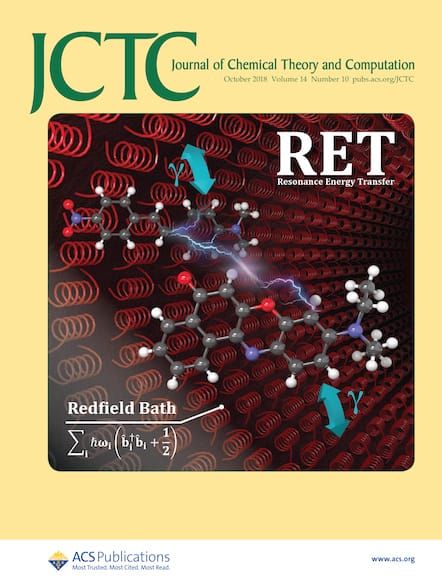计算原子在分子和金属表面的非键势的经典模拟。
IF 5.5
1区 化学
Q2 CHEMISTRY, PHYSICAL
引用次数: 0
摘要
真实分子的经典模拟需要组成原子之间真实的非键相互作用,传统上,这些相互作用被调整为与液体性质很好地一致,并在相似的原子类型中广泛复制。在这项工作中,我们提出了计算原子间C12短程斥力和C6色散引力的从头算方法。我们将斥力与原子附近的电子密度低于某一阈值的距离联系起来,该阈值与ops力场中原子的半径相匹配。我们通过将McLachlan积分公式应用于分子中每个原子的极化率贡献作为虚频率的函数来计算色散吸引力。这些极化率贡献可以通过GAMESS中随时间变化的Hartree-Fock方法来计算,该方法方便地划分了键和孤对之间的总极化率。我们的方法产生的C12和C6参数值与现有的OPLS值很好地一致,当应用于来自virtualchemistry.org存档的100多个有机分子中的近200种原子类型时。我们验证了ops原子类型的不同实例具有几乎相同的极化率,为我们的方法和基于局部化学环境的原子类型提供了信任。我们将计算色散相互作用的频率积分方法扩展到金属表面附近分子中的原子,该方法筛选附近的波动场,其频率响应受等离子体频率限制。筛选相当于原子与之相互作用的波动成像偶极子,与金属半空间产生1/z3相互作用。这种相互作用可以方便地表示为与每个金属原子的传统1/r6相互作用,在半空间上求和。本文章由计算机程序翻译,如有差异,请以英文原文为准。
Calculating Nonbonded Potentials for Classical Simulations of Atoms in Molecules and Metal Surfaces.
Classical simulations of real molecules require realistic nonbonded interactions between constituent atoms, which have traditionally been adjusted for good agreement with liquid properties and copied extensively among similar atom types. In this work, we propose ab initio methods to compute both the C12 short-range repulsion and the C6 dispersive attraction between atoms. We relate the repulsion to the distance at which the electron density near an atom falls below a certain threshold, chosen to match radii for atoms in the OPLS force field. We compute the dispersive attraction by applying the McLachlan integral formula to the polarizability contributions of each atom in a molecule as a function of imaginary frequency. These polarizability contributions can be computed by time-dependent Hartree-Fock methods in GAMESS, which conveniently partitions the total polarizability among bonds and lone pairs. Our method produces values for both C12 and C6 parameters in good agreement with existing OPLS values when applied to nearly 200 atom types in over 100 organic molecules from the virtualchemistry.org archive. We verify that different instances of OPLS atom types have nearly identical polarizabilities, lending credence both to our method and to atom types based on local chemical environments. We extend our frequency-integral method for computing dispersive interactions to atoms in molecules near metal surfaces, which screen nearby fluctuating fields, with a frequency response limited by the plasma frequency. The screening is equivalent to a fluctuating image dipole with which the atom interacts, giving rise to a 1/z3 interaction with a metal half-space. This interaction can be conveniently represented as a conventional 1/r6 interaction with each metal atom, summed over the half-space.
求助全文
通过发布文献求助,成功后即可免费获取论文全文。
去求助
来源期刊

Journal of Chemical Theory and Computation
化学-物理:原子、分子和化学物理
CiteScore
9.90
自引率
16.40%
发文量
568
审稿时长
1 months
期刊介绍:
The Journal of Chemical Theory and Computation invites new and original contributions with the understanding that, if accepted, they will not be published elsewhere. Papers reporting new theories, methodology, and/or important applications in quantum electronic structure, molecular dynamics, and statistical mechanics are appropriate for submission to this Journal. Specific topics include advances in or applications of ab initio quantum mechanics, density functional theory, design and properties of new materials, surface science, Monte Carlo simulations, solvation models, QM/MM calculations, biomolecular structure prediction, and molecular dynamics in the broadest sense including gas-phase dynamics, ab initio dynamics, biomolecular dynamics, and protein folding. The Journal does not consider papers that are straightforward applications of known methods including DFT and molecular dynamics. The Journal favors submissions that include advances in theory or methodology with applications to compelling problems.
 求助内容:
求助内容: 应助结果提醒方式:
应助结果提醒方式:


